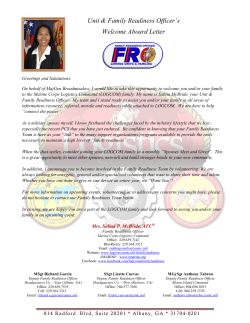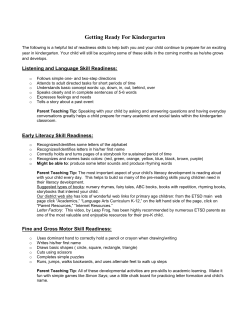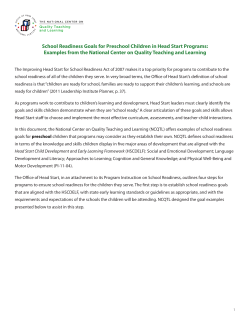
REACHING ALL CHILDREN IN THE CLASSROOM: AN OVERVIEW OF DIFFERENTIATION STRATEGIES
REACHING ALL CHILDREN IN THE CLASSROOM: AN OVERVIEW OF DIFFERENTIATION STRATEGIES COMPILED BY JEN MITCHELL 2 Differentiation: Introduction That students differ may be inconvenient, but it is inescapable. Adapting to that diversity is the inevitable price of productivity, high standards, and fairness to the students. ~Theodore Sizer Sizer, T. (1984). Horace’s Compromise: The Dilemma of the American High School (p. 194). Boston: HoughtonMifflin 3 Curriculum differentiation is a process used to maximize student learning by improving the match between a student's individual needs and the curriculum. A general term used to describe the range of strategies, which are used to ensure children’s needs are met. Curriculum differentiation is a broad term referring to the need to tailor teaching environments and practices to create appropriately different learning experiences for different students. Adapting the curriculum to meet the unique needs of learners by making modifications in complexity, depth, and pacing. Teachers can Differentiate the: CONTENT: PROCESS: PRODUCT: Knowledge, skills and attitudes we 4 want children to learn; differentiating content requires that students are pre-tested so the teacher can identify the students who do not require direct instruction Varying learning activities / strategies to provide appropriate methods for students to explore the concepts; important to give students alternative paths to manipulate the ideas embedded within the concept (different grouping methods, graphic organizers, maps, diagrams, or charts) Varying the complexity of the product that students create to demonstrate mastery of the concepts; students below grade level may have different performance expectations than students above grade level (ie. more complex or more advanced thinking~ Bloom’s Taxonomy) According to Students’: READINESS/ DEVELOPMENTAL: Some students are ready for different concepts, skills, or strategies; others may lack the foundation needed to progress to further levels INTEREST: LEARNING STYLE Student interest inventories provide information to plan different activities that respond to individual student’s interest Individual student preference for where, when or how students obtain and process information (visual, auditory, kinesthetic; multiple intelligences; environment, social organization, physical circumstance, emotional climate, psychological climate) 5 Differentiation: WHAT To Teach Essential Questions •Curriculum Map Template •Unit Design •Lesson Planning •Skills List • What to Teach??? 6 Essential Questions ~ conceptual understandings (Mctighe & Wiggins, 2004, p. 91, 93-93) Curriculum Map/Unit Design Curriculum Map Template See other unit template Sample Skills List (Heacox, p. 61) Turn, Share and/or revise Essential Questions or Skills for your Unit of Study 7 Lesson and Unit Design DIFFERENTIATION STRATEGIES Parts I, II and III Differentiation Strategies 9 PART I Pre-Assessment Curriculum Compacting Learning Contracts PART II Differentiate by Interest, Learning Style & Challenge Levels Flexible Grouping Part III Tiered Assignments Choice: Project Menus/Tic Tac Toe Anchoring Activities Varying Questions 10 Differentiation Strategies: Part I Pre Assessment •Curriculum Compacting •Learning Contracts • PRIOR KNOWLEDGE/READINESS: The Value of Pre-Assessment... Textbook Pretest Student/Teacher Conference - as short as a 5 minute talk K-N-W Chart - What do I Know, Need to know & Want to know Journal - Write what you know about... List - If I say ... What does it make you think of? Concept Map... Student Reflection ~You can’t figure out what to teach ’em if you don’t know ’em! Jot down some ideas for “pre-learning assessment” for your unit; you may want to think about some strategies represented in Beyond the Blueprint, Chapter 7 I’ve mapped out the concepts I’ve already grasped to save you time. 12 PACING: Curriculum Compacting Modify and/or streamline regular curriculum to: eliminate repetition of previously mastered material upgrade the challenge level of the regular curriculum determine student “readiness” provide time for enrichment and/or acceleration activities Eight Compacting Steps (Student Readiness) 1. 2. 3. 4. 5. 6. 7. 8. Identify objectives ( UbD Stage 1) Create pretest (end of unit expectations; UbD Stage 2) Identify students to Pretest Administer Pretest Eliminate content in areas of mastery Streamline instruction (UbD Stage 3) Offer enrichment or acceleration activities (Heacox, p. 139, 142) Keep records of progress Learning Contracts A written agreement between the student and the teacher which includes opportunities for the student to work relatively independently on primarily teacher-directed material. The student has: Some freedom in acquiring skills and understandings Responsibility for learning independently Guidelines for completing work Guidelines for appropriate behavior Expectations tailored to readiness level • See sample: Compacting Form and Project Description (Heacox, p.142) • Turn & Talk: Explain how learning contracts support curriculum compacting? Differentiation Strategies: Part II 16 Differentiation by Interest, Learning Style (choice) & Readiness (challenge levels) • • Choice: Gardner’s Multiple Intelligences • Choice: Projects, Presentations & Performance (Heacox) • Choice: Products & Performances/Performance Tasks (McTighe & Wiggins) • Readiness: Bloom’s Taxonomy~ Challenge Levels • Choice by Challenge Level & Learning Style (Heacox) Flexible Grouping • • 3 Kinds of Groups (Heacox) Differentiate by Choice: Interest 17 Interest Inventories (Heacox, p. 29-31) Grouping Index Cards/Use for Centers: Item 5: Have students list topics they rated 1 and 2 (use to create teams of common interests) Item 7: Use to group for exploratory topics Item 13: Use to identify “specialists” for particular areas of study Item 19/20: To create partnerships or learning groups Review the inventory; how do you think and learn? Reflect upon how your strengths have been supported/neglected. Turn and share. Differentiate by Students’ Learning Style & Challenge Levels 18 Learning Style: How We Think and Learn Variety: Multiple Intelligences (Heacox, p. 36-37) Howard Gardner (Projects, Presentations, Performances; Heacox, p. 34-35) Challenge Levels (readiness): Rigor, Relevance & Complexity Challenge! NOT more. Blooms Taxonomy: 6 Levels of Thinking Challenge Levels (Heacox, p. 69 & 75) CHOICE: Challenge & Learning Style: 19 Bloom’s Taxonomy & Gardner’s M.I. Brief Lesson Plan (Heacox, p. 73, 156) Content + Process + Product = learning experience Content=what are students learning about? Process=what level of thinking is required? Product= how will the results of learning be represented/ assessed? Ex: Compare and contrast a scene in a novel with the movie version of the same scene by presenting your ideas in a storyboard of words and pictures. Your Turn… CHOICE: Challenge & Learning Style: 20 Double-sided Lesson Plan Matrix (Bloom’s & Multiple Intelligences) Heaxox, p. 78-79, 82-83 Small group (triad/diad) plan to incorporate concepts into your unit of study using the matrix… Flexible Grouping “A hallmark of an effective differentiated classroom….is the use of flexible grouping, which accommodates students who are strong in some areas and weaker in others. ~Carol Tomlinson Three Types of Groups: I. Flexible (readiness, learning style…) II. Ability/Aptitude III. Cooperative (Heacox, p. 87) 21 22 Differentiation Strategies: Part III Tiered Activities •Choice: Tic Tac Toe •Anchoring Activity •Questioning & Discussion • Tiered Activities Tiered Instruction features: Whole group introduction and initial instruction Identification of developmental differences Ladder Analogy (bottom – up; challenge/complexity) Increase or Decrease the: Abstraction/Challenge Levels (ie. application, analysis & synthesis) Extent of Support Complexity of: outcomes resources (reading levels, types of text [on-line, magazine, etc…], based on prior-knowledge levels) processes (way in which students obtain information) products (M.I. products) Tiered Assignment~ Middle School Unit: Dinosaurs 24 Objective: In their study of dinosaurs, the students will be able to research and identify various theories of dinosaur extinction. Task 1 - After researching and identifying various theories of dinosaur extinction, students will be able to create their own theory and draw a picture or diagram illustrating that theory. Task 2 - After researching and identifying various theories of dinosaur extinction, students will be able to create a visual representation of their theory (i.e. diorama, timeline, or three dimensional model). Task 3 - After researching and identifying various theories of dinosaur extinction, students will be able to create a visual representation of their theory and defend their theory during a class debate. “Shipwreck at the Bottom of the World” example & planning template Brainstorm your own! CHOICE: 25 Use as a choice of required products Code to identify challenge levels or learning style Warm-up/Cool-down activities Pure “choice” time Alternatives for students (via curriculum compacting) Project Menu Cards (Heacox, p. 106) Tic Tac Toe 26 Tic Tac Toe *see book report example Anchoring Activity (See the Anchoring Activity for: The Giver) 27 Self-paced, purposeful, content-driven activities that students can work on independently throughout a unit, a grading period, or longer Meaningful ongoing activities related to the curriculum A list of activities that a student can do at any time A long-term project An activity center/learning station located in the room These activities must be worthy of a student’s time and appropriate to their learning needs Management Suggestions Explain the activity and the procedures with the whole class Make expectations clear – develop ground rules for: Behavior Performance Use tasks that require time and thinking – this is not an extension of the “seat-work” concept Provide clear instructions, materials, responsibilities, check points, and expectations (rubrics) QUESTIONING & DISCUSSION "I have no answers, only questions." ~Socrates, c. 300 B.C. University of Nebraska-Lincoln Study: of questions teachers ask approximately: 60% require only recall of facts 20% require students to think 20% are procedural in nature Resource: Appendix B: Differentiating Classroom Discussion (Heacox, pgs. 150 & 152); how would you use this resource during instruction? Open Ended Questions 30 have no “right” answer can be discussed and debated provoke and sustain student inquiry raise other important questions address the conceptual or philosophical foundations of a discipline stimulate vital, ongoing reflection of big ideas and assumptions 31 “Summer’s over kids! Now, all you round pegs get back into your square holes!” The biggest mistake we have made in past centuries in teaching has been to treat all children as if they were variants of the same individual and thus to feel justified in teaching them the same subjects in the same ways. ~Howard Gardner
© Copyright 2025










